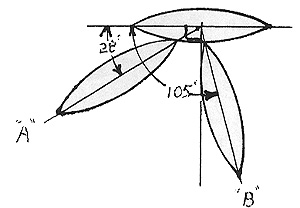During recent battles fought with IRON & STEAM rules for ACW naval, it has become apparent that the ramming rules on page 12 are ambiguous at best, and in need of clarification and revision. During the last game, one astute player observed that if a ship is dead in the water, it is impossible to ram it since it doesn't leave a wake! In sight of these recent experiences, I offer the following modifications:
1. In order to make a ram attack, the ramming player merely writes "ram" for his ship's orders, as well as, indicating the intended target. Prior to moving any vessels in the movement execution phase, the ramming player announces his intention to ram.
2. Determine the target's ability to react/avoid the ram attack: The ramming player and the target player each roll a D10. If the target player rolls = or > than the ramming player, then he may disregard his written orders during movement. If the ramming player rolls > than the target player, then the target ship must move the first 1/4 of its move. If the ramming player rolls double the target player's roll, then the target player must move the first 1/2 of its plotted move.
3. Move Ships: The ramming player chooses whether he wishes to move first or second. The first ship moves 1" of its movement, then the second ship moves 1". Alternate moving 1" increments until the ramming ship contacts the target ship model, or until both ships have exhausted their movement. IMPORTANT: During the course of alternating movement, it is possible for the target ship to ram its attacker, if it can contact its enemy with its bow during its 1" incremental movement. This can make ramming head-on a dangerous proposition.
If two enemy ships have been plotted to ram each other, each player rolls a D10. The high roll chooses to move first or second, then alternate moving as above.
4. If the ship models have been moved into contact, determine the angle of impact. Imagine a straight line drawn through the length of each vessel. Measure the angle formed by these intersecting lines. If the angle of impact is between 45° and 135°, then the ramming vessel gains a bonus for the chance to successfully ram. In other words, if the ramming vessel can contact the target vessel at a right angle, or within 45° of a right angle, this increases the chance of a successful ram attack.
 In diagram 1, ram "A" is striking the target vessel at an angle of 28°. Since this is a relatively narrow angle of attack, there is a possibility of the ram glancing off of the target vessel without causing significant damage: ram "A" does not receive the bonus. Ram "B" is striking the target at an angle of 105°. or nearly perpendicular. Ram "B" will receive the +30% bonus.
In diagram 1, ram "A" is striking the target vessel at an angle of 28°. Since this is a relatively narrow angle of attack, there is a possibility of the ram glancing off of the target vessel without causing significant damage: ram "A" does not receive the bonus. Ram "B" is striking the target at an angle of 105°. or nearly perpendicular. Ram "B" will receive the +30% bonus.
5 Calculate the chance to successfully ram:
- Ram chance 50%
Angle of attack between 45° and 135° +30%
Difference in ships turning radii per inch of difference +/-5%*
Difference in ships current speed per inch of difference +/-5% **
*If the target ship has a smaller radius, subtract 5% per inch of difference. If the ramming ship has a smaller turning radius, add 5% per inch of difference.
**If the target ship is faster, subtract 5% per inch of difference. If the ramming ship is faster, add 5% per inch of difference. Calculate this based on both ships current speeds.
If the target ship is dead in the water, then the ram is automatically successful.
6. If the ram attack is successful, determine damage to both ships per the rules on page 13. If the ram is unsuccessful, continue moving both ships the remainder of their movement (they are assumed to have glanced off of each other without damage, or to have missed entirely.
7. Collisions: If, during movement, ships which were not ordered to ram contact each other collide, there is a 25% chance of an unintentional ram. No modifiers apply to this roll . This applies to all vessels, friendly and enemy. If an unintentional ram occurs, calculate the damage per page 13.
8. Fouling (optional): After a successful ram/collision, roll to determine if the two ships become fouled.
Modifiers:
One or both ships are rigged (sailing) vessels +20%
One vessel is an ironclad -20%
Both vessels are ironclads -40%
Roll percentage dice: if the modified role is greater than 50, then the ships are fouled.
Fouled ships may not be given movement orders. During the repair phase, roll to unfoul. Use the same modifiers as for fouling: if the modified roll is 50 or less. the ships are unfouled and may be given movement orders on the next turn. If. while fouled, one ship sinks immediately make one final attempt to unfoul. If unsuccessful, both ships sink together!
Hopefully, these rules are easier to understand than the ones in FIRE & STEAM. I have tried to increase the chances of successfully conducting ramming attacks. without making major revisions to the rules as written.
Back to The Herald 4 Table of Contents
Back to The Herald List of Issues
Back to MagWeb Master Magazine List
© Copyright 1995 by HMGS-GL.
This article appears in MagWeb.com (Magazine Web) on the Internet World Wide Web. Other military history articles and gaming articles are available at http://www.magweb.com